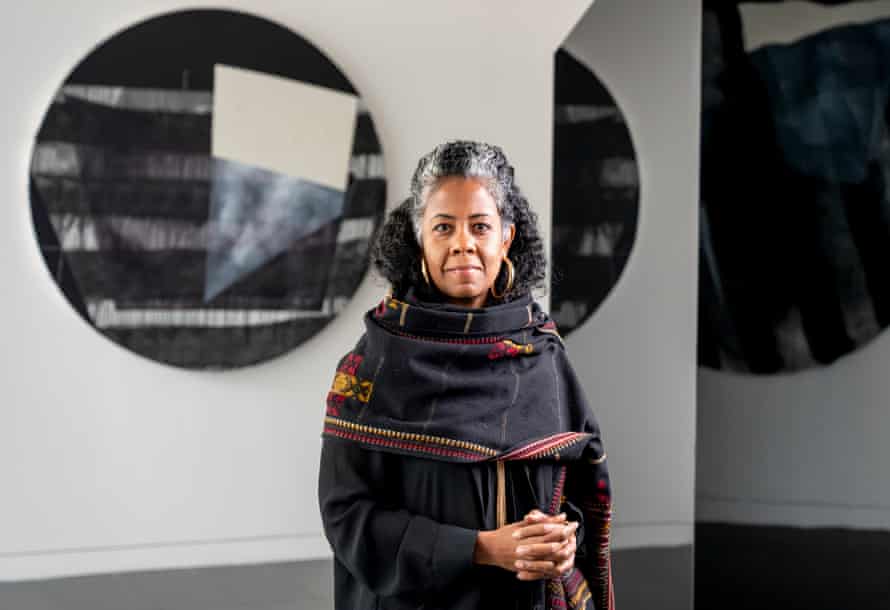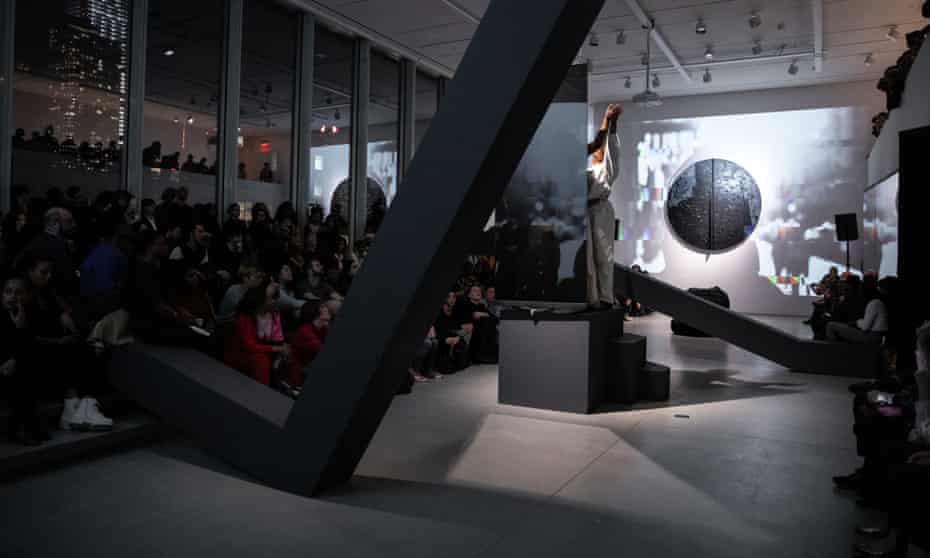Liquid liberation: artist Torkwase Dyson on her aquatic obsession
From the transportation of slaves across the Atlantic to the drowning of a teenager at Lake Michigan, the artist explores how water connects to Black history – and now she’s looking inside the human body

Torkwase Dyson likes to be near water. “I look for it,” she says, “whether it’s a river, a lake or the ocean. I prefer to be in an environment that has those things.” The Brooklyn-based artist has long been concerned with how such watery spaces connect to the climate crisis, colonisation and Black history. Her 2019 exhibition 1919: Black Water featured paintings and sculptures exploring the murder of Eugene Williams who, along with four other Black teenagers, went swimming in Lake Michigan on a homemade raft. It drifted towards a segregated white beach and Williams was struck by a rock thrown by someone there. He drowned – an event that sparked the Chicago race riot of 1919.
Dyson’s explorations continue this month, as Liquid a Place opens at the Pace gallery in London. The show is a result of time Dyson spent by the River Thames and her research into the people and objects it has transported. “The title comes from my interest in investigating the water in our own bodies. All of the science proves that water holds memory. So Liquid a Place is saying our bodies are a place, a site of information.” The sculptures are partly inspired by pipelines, as well as the Middle Passage, the route enslaved Africans took across the Atlantic Ocean.
Music, poetry, dance and sound will also ring through the gallery, in a special three-day programme that is a continuation of her 2019 work I Can Drink the Distance. Shown in New York, this was a two-act performance considering the Anthropocene‘s relationship to racism, plantation slavery, and how white supremacy informed industrialisation. Performers include former Atari Teenage Riot member Rowdy SS and electronic musician Gaika. “I’ve invited some pretty fantastic thinkers to collaborate,” Dyson says.
The artist was born in Chicago in 1970. “I started making art intentionally in my last year at Tougaloo College in Mississippi,” she says. “I was finishing my sociology degree and, in the last semester, took a drawing and sculpture class and I wasn’t bad at it.” Her early influences included such African American artists as Samella Lewis, Minnie Evans and David C Driskell. “The penny dropped with Benny Andrews,” says Dyson, referring to the figurative painter, collagist and activist who helped found the Black Emergency Cultural Coalition. “I met him when he gave me my first ever individual crit at Tougaloo Art Colony. His exact words were, ‘You can paint – so what?’ These words stay with me.”

Dyson’s work is typically rendered in intensely black pigment and materialises from hundreds of drawings. “Momentum comes from the drawings, the making with my hands, which then produces a set of questions and a set of curiosities.” Although her works vary hugely in material and form, from layered acrylic paintings to plexiglass tetrahedron sculptures, they are all unified by a profound sense of geometry, with sharp lines and sleek angular compositions. She’s always thinking about bodies, how they move through buildings, architectural structures and colonial landscapes.
The shapes in Dyson’s work are never arbitrary, though. They always connect to something of symbolic historical meaning. From triangles to rectangles, circles to trapezoids, she is concerned with configurations of freedom. Previous works such as 2018’s Hyper Shapes, a series of brush mark drawings, are informed by the places enslaved people used to hide in to get free. In the painting Plantationocene, from the Black Water exhibition, the boys’ homemade raft is seen from above, surrounded by glistening water. Although it led to William’s death and a riot, for Dyson, the raft represents a site of self-liberation, how Black people find ways to play and be mobile in white spaces.
Dyson is also showcasing a new work for Back to Earth, the Serpentine galleries’multiyear project in which 60 artists, architects and poets respond to the climate crisis. Dyson will be presenting a sound installation based on breathing in the age of pollution. “After George Floyd and during Covid,” she says, “I started exploring breathing and brain function.” She also relates air and breathing to meditation, and finds further links with “white supremacy, policing and American torture”.
Given that her work is so invested in the body, I ask Dyson what she thinks of Covid. “It’s a continuum,” she says. “It has exacerbated the system. But what we have learned from Covid is only in relation to how far technology, social science and our industries have gone – and how advanced capitalism is.”
Dyson’s dream is to install a large painting, or a site-specific multimedia work, in the Gulf of Mexico – an “architectural abstraction” based on Pilate’s earring, a symbolic element in Toni Morrison’s Song of Solomon. “It’s where I’ve spent the most time diving,” she explains, “and my grandfather is from New Orleans.”
Until then, her main concern is to continue exploring forms of self-liberation, specifically from systems of degradation and dispossession. “Black people and brown people have triumphed in more systems than racism,” she says. “How does liberation happen? I’m interested in that as a way to create.”